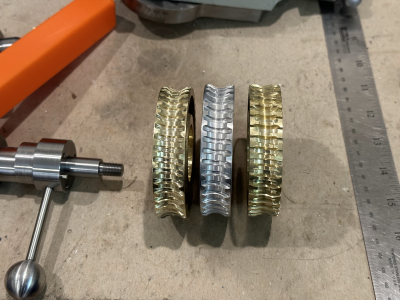-
Welcome back Guest! Did you know you can mentor other members here at H-M? If not, please check out our Relaunch of Hobby Machinist Mentoring Program!
You are using an out of date browser. It may not display this or other websites correctly.
You should upgrade or use an alternative browser.
You should upgrade or use an alternative browser.
Group Project: Dividing Head - The Build
- Thread starter Flyinfool
- Start date
- Joined
- Sep 8, 2019
- Messages
- 4,392
I have all of the spindle nuts (heavy hex nuts).I'm pretty sure someone bought spindle nuts.
- Joined
- Mar 25, 2013
- Messages
- 4,615
Still playing on how to best cut the gear. My 6 point cutter did not have side relief and struggled to cut deep enough. The rigidity of my toy Sherline was also an issue. Even Viagra did not help this.
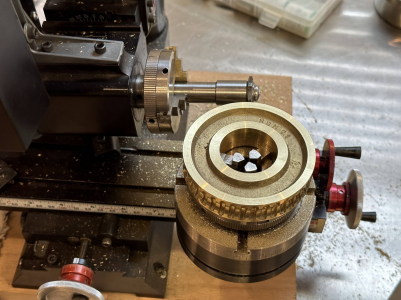
I decided to try single point cutting. I went through my scrap bin and found a 6mm chunk of carbide. I break a lot of drills. I ground a 14.5 deg taper using the toolpost grinder (diamond wheel ) on my lathe and then cut a flat surface to the center point:
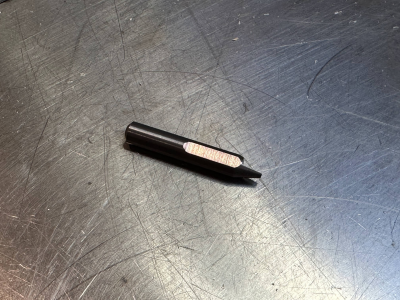
I mounted this in a 5/8" mandrel. I tilted the rotary table 4.55 deg nose down (proper lead angle) using trigonometry and an appropriate height block:
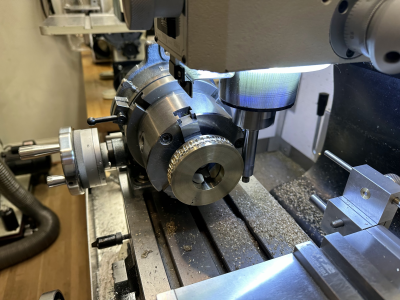
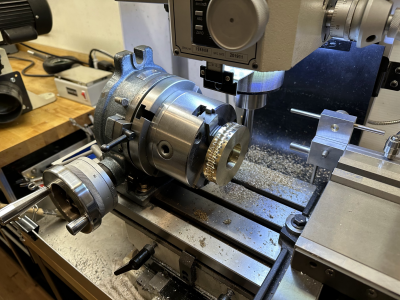
I machined two gears this way and they came out good. I then ran them in against my shop made hob. I think they will work well.
I have to say, the carbide cutter held up perfectly; I was afraid it would break. The alloy steel hob is getting significant wear from the bronze is is now probably shot. I'm surprised the steel did not hold up better. BTW this method is super tedious because you have to cut 40 teeth to specific depth at 9 deg increments. It takes a long time and is easy to **** up.

I decided to try single point cutting. I went through my scrap bin and found a 6mm chunk of carbide. I break a lot of drills. I ground a 14.5 deg taper using the toolpost grinder (diamond wheel ) on my lathe and then cut a flat surface to the center point:

I mounted this in a 5/8" mandrel. I tilted the rotary table 4.55 deg nose down (proper lead angle) using trigonometry and an appropriate height block:


I machined two gears this way and they came out good. I then ran them in against my shop made hob. I think they will work well.
I have to say, the carbide cutter held up perfectly; I was afraid it would break. The alloy steel hob is getting significant wear from the bronze is is now probably shot. I'm surprised the steel did not hold up better. BTW this method is super tedious because you have to cut 40 teeth to specific depth at 9 deg increments. It takes a long time and is easy to **** up.
Last edited:
- Joined
- Nov 24, 2014
- Messages
- 3,164
@rwm
I've been lurking since the beginning of this adventure.
I'm relieved to see that you finally went to the 'one tooth at a time' approach.
Now that you've got a (some) single pointed gear, I'm wondering if using the Acme tap, at full tooth engagement depth (gear free wheeling) as a 'chaser' would serve to be certain of a proper (non- interfering) gear tooth profile. You could set it up and turn the spindle (tap) by hand to try it out. Just a thought. YMMV.
I've been lurking since the beginning of this adventure.
I'm relieved to see that you finally went to the 'one tooth at a time' approach.
Now that you've got a (some) single pointed gear, I'm wondering if using the Acme tap, at full tooth engagement depth (gear free wheeling) as a 'chaser' would serve to be certain of a proper (non- interfering) gear tooth profile. You could set it up and turn the spindle (tap) by hand to try it out. Just a thought. YMMV.
- Joined
- Mar 25, 2013
- Messages
- 4,615
I tried that. It works but may not provide an advantage now that the teeth are full depth. Believe it or not, the tap and the acme threaded rod I sourced from MMC do not have exactly the same tooth shape. As noted earlier, you should run in the gear with the same screw you intend to use. Also, single point cutting cannot give the exact correct profile of the teeth compared with running against a screw or hob.
- Joined
- Sep 8, 2019
- Messages
- 4,392
- Joined
- Aug 13, 2020
- Messages
- 1,342
I got through all but one of the main bases this weekend, and while I had the rotary table set up. . . . this:
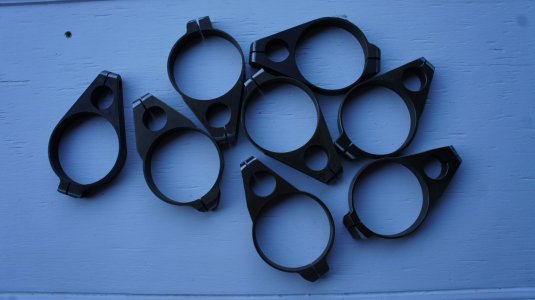
Some look better than others, but they are all functional (else I wouldn't have been able to machine them.
I make an "arbor" of sorts to hold the bases to the rotary table so that I could machine the round on the outside of the hole. I clamped these clamps to the same arbor, and then is just a matter of going round and round.

Some look better than others, but they are all functional (else I wouldn't have been able to machine them.
I make an "arbor" of sorts to hold the bases to the rotary table so that I could machine the round on the outside of the hole. I clamped these clamps to the same arbor, and then is just a matter of going round and round.
- Joined
- Aug 13, 2020
- Messages
- 1,342
Not blued. I heat in a toaster oven to 450, then dump them in used motor oil. VERY rust resistant.
The divergence from the plan was to make the clamp one thickness over as much of the diameter as possible in order to eliminate all the bending happening in one place.
The divergence from the plan was to make the clamp one thickness over as much of the diameter as possible in order to eliminate all the bending happening in one place.


